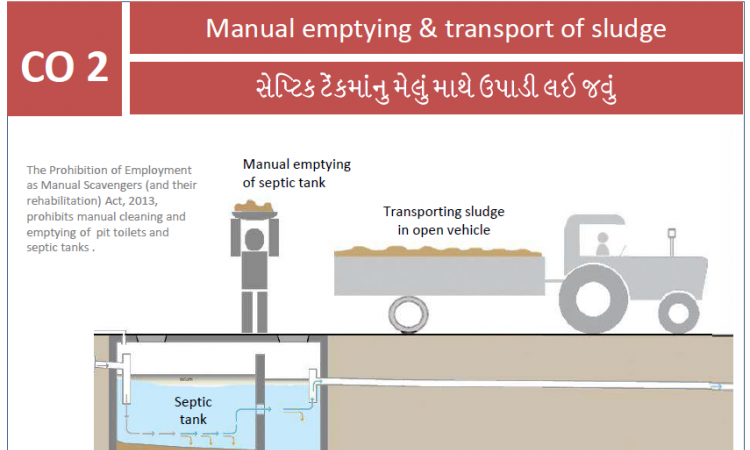
On-site sanitation systems are options which help treat the waste at source, rather than dealing with it several miles away in a centralized manner. In the absence of sewerage systems and piped supplies, communities have to devise decentralized ways to deal with their shit. Some of the most common on-site sanitation systems include septic tanks and pit latrines.
On-site sanitation flash cards
Flash cards developed by the Urban Management Centre and CEPT University’s Performance Assessment System classify different on-site sanitations available, encompassing all four aspects in the value chain: Collection/storage, conveyance, semi-centralized treatment and disposal/use.
Visually appealing and easily comprehendible graphics from Eawag’s ‘Online Compendium of Sanitation Systems and Technologies’ help better illustrate the entire value chain of various types of on-site sanitation systems that are currently in use.
A) Collection systems
These systems deal with collecting and storing black water from latrines. It can also include partial anaerobic treatment of solids that settle down in tanks and pits. The following three collection systems find a place in the flash cards.
- Pour flush latrine connected to single pit – Widely used; pit collects and stores faecal matter; walls may or may not be lined; bottom left unlined to help infiltration; best suited for rural and peri-urban areas.
- Pour flush latrine connected to twin pits – Similar to the previous model, only difference being the presence of two pits in place of one; only one pit is used at any given time; once the pit fills up the second is used; gives time for faecal matter to degrade.
- Pour flush latrine connected to septic tank – Blackwater and greywater enter airtight tank; solids settle down; anaerobic primary treatment of sewage; accumulated sludge to be removed every2-3 years.
B) Conveyance systems
Sewage from the point of origin is conveyed using one of the following means to certain centralized or semi-centralized areas for further treatment.
- Individual toilets discharging into drains – Blackwater from pour flush latrines directed into drains; empties into water bodies without any treatment; against law.
- Manual emptying and transport of sludge – Sludge removed manually from pits and septic tanks; prohibited under the Manual Scavengers (and their Rehabilitation) Act, 2013.
- Motorized emptying & transport of sludge – Sludge removed using motorized pumps; men handle hoses and pumps, but no direct contact with faecal sludge; transported away using tankers.
- Effluent discharged in SW drain – Recommended only as an interim measure when effluent is high or no other provision is available for infiltration or transportation.
- Septic tank connected to settled sewer – Sewage from septic tanks directed to small sewer network; transports wastewater without suspended solids; no requirement for minimum flow or slope for functioning.
- Effluent discharged in chamber, emptied – Septic tank based system; no capacity for onsite infiltration; effluent collected into a chamber; transported using vacuum suction trucks.
- Sludge and effluent emptied in main sewer line – Sludge collected using vacuum suction trucks dumped into underground sewer lines; treated using STPs.
C) Treatment
Semi centralized treatment options cater to the needs of a larger area like entire neighbourhoods or even the entire city. These can be broadly classified into two types: One, to deal with the black or grey water from the latrines and bathrooms and, systems to manage the sludge.
- Sludge treated using drying beds – Sludge dumped on a permeable bed; leachate collected; sludge dries by evaporation; volume reduces; dried sludge is put through another round of treatment to remove pathogens.
- Sludge & effluent emptied in sewer, treated at STP – Sewage treatment plants remove pathogens and organics from grey, brown and black water; resulting effluent safe for disposal in water bodies.
D) Re-use or disposal
Once partially treated or otherwise, the sludge can be injected into the soil either as fertilizers for plants or be disposed off in a form that is not harmful to the environment. Some of the most commonly followed practices are listed here.
- Untreated sludge emptied used as manure in farms – sludge from pit latrines and septic tanks contain very few contaminants; dried and used for agriculture; should be tested before application; use needs to be regulated.
- Sludge emptied in water bodies – Dumped without any treatment; unsafe; causes water pollution; prohibited under environmental laws.
- Sludge emptied at dump site – Untreated sludge dumped in open dump sites; unsafe; may result in groundwater contamination.
- Sludge emptied at vacant plots – Untreated waste dumped on vacant plots; unsafe; may cause soil and ground water contamination.
- Pit humus from twin pits used as manure – Organic matter gets degraded over time in pits when left undisturbed; resultant soil-like material is called pit humus; can be applied on the soil; excellent soil conditioner.
- Effluent treated & disposed through soak pit – Pre-settled effluent from septic tanks diverted into porous walled chambers; water infiltrates into surrounding soil.
- Storage or surface disposal of treated sludge – Sludge stockpiled in a disposal open site; cannot be reused anywhere.
- Treated effluent used for irrigation – Waste water that has undergone physical and biological treatment may be used in agriculture; helps reduce dependence on fresh water.
- Treated sludge used in agriculture – Digested or stabilized sludge applied on the land; used for agriculture or landscaping.
- Treated effluent disposed in water body – treated effluent directly discharged into water bodies; may also be injected into the ground post-treatment; helps in ground water recharge.
You can download the flashcards as a PDF document from the link below.
/articles/site-sanitation-systems-flash-cards-managing-faecal-sludge-and-effluents